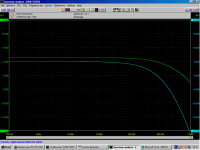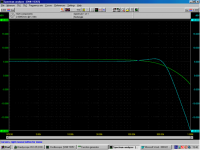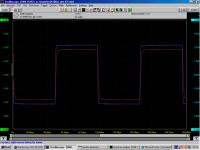Hi,
I am researching for building a classic single ended Class A headphone amplifier. First of all are there any good designs around that I could start looking at ?
Secondly, if I design this from scratch I would like to use BJTs with high linearity (in hopes of using as minimal negative feedback as possible). Since this is for light headphone duty I don't expect current requirements to be in any access of ~20ma per channel. Any suggestions here ? Do you know of any good ones ?
Over to you for your thoughts....
I am researching for building a classic single ended Class A headphone amplifier. First of all are there any good designs around that I could start looking at ?
Secondly, if I design this from scratch I would like to use BJTs with high linearity (in hopes of using as minimal negative feedback as possible). Since this is for light headphone duty I don't expect current requirements to be in any access of ~20ma per channel. Any suggestions here ? Do you know of any good ones ?
Over to you for your thoughts....
headphones differ greatly in impedance and sensitivity: 16-600 Ohms and 88-119 dB/mW for dynamic headphones
so 20mA may not be enough - look at Gilmore's "A Pure Class A Dynamic Headphone Amplifier" on Headwize
http://headwize.com/projects/index.htm
quickest way to high measured linearity over the audio range is to use op amps - composite amps with separate high current output stages inside the feedback loop either discrete or using recent DSL driver CFA op amps can have unmeasureably low audio frequency distortion - well below the 120-130 dB spot noise floor of the better audio ADC cards
so 20mA may not be enough - look at Gilmore's "A Pure Class A Dynamic Headphone Amplifier" on Headwize
http://headwize.com/projects/index.htm
quickest way to high measured linearity over the audio range is to use op amps - composite amps with separate high current output stages inside the feedback loop either discrete or using recent DSL driver CFA op amps can have unmeasureably low audio frequency distortion - well below the 120-130 dB spot noise floor of the better audio ADC cards
I forgot to mention - I want to really keep it 'simple'. Simple as in just one active device. Just one BJT per channel. I already have a good opamp amplifier(Corda Headsix) so want to try something different now.
am not as much concerned about 'measured' linearity as much as intrinsic/natural linearity of the device itself, before feedback.
yes I realize the wide range of headphone power requirements, but I don't intend to build a 'marketable' product to cater to that range. This is custom. If it works for the two headphones I have(AKG 501, Koss KSC75) that should be enough. And after some tests & trials I have concluded that I wouldn't need much over a 1V swing and 30ma draw.
am not as much concerned about 'measured' linearity as much as intrinsic/natural linearity of the device itself, before feedback.
yes I realize the wide range of headphone power requirements, but I don't intend to build a 'marketable' product to cater to that range. This is custom. If it works for the two headphones I have(AKG 501, Koss KSC75) that should be enough. And after some tests & trials I have concluded that I wouldn't need much over a 1V swing and 30ma draw.
simple and very linear is just using iPod's output for 1V, 30mA
"High linearity" isn't going to happen with a single device
if you expect a different sound from a "simple" circuit it will most likely be because the amplification is less accurate/linear
the best linearity from a single device would come from heavy bias so you use a smaller fraction of its nonlinear response curve
then you could argue over whether degeneration helps or if more low order distortion is less noticeable than the feedback introduced higher order low level distortion components
which also depends on the music you listen to - its commonly pointed out that "audiophile" demos often use "simple" music such that the IMD products with the higher levels of low order distortion doesn't muddy the sound as it would with a complex symphonic work
"High linearity" isn't going to happen with a single device
if you expect a different sound from a "simple" circuit it will most likely be because the amplification is less accurate/linear
the best linearity from a single device would come from heavy bias so you use a smaller fraction of its nonlinear response curve
then you could argue over whether degeneration helps or if more low order distortion is less noticeable than the feedback introduced higher order low level distortion components
which also depends on the music you listen to - its commonly pointed out that "audiophile" demos often use "simple" music such that the IMD products with the higher levels of low order distortion doesn't muddy the sound as it would with a complex symphonic work
If you really insist on one BJT per channel, your options are very limited. Just use a transistor applications textbook. I suspect you'll be unhappy with its performance.
To see what the simplest practical circuit would be using BJTs, take a look at this article to see why the author went from one BJT to three:
http://sound.westhost.com/project36.htm
This can be built up as either a speaker or headphone amp.
Also have a look at this:
http://www.tcaas.btinternet.co.uk/jlhphones.htm
If you don't insist on BJTs, and don't need gain, look at this:
http://headwize.com/projects/showfile.php?file=szeke1_prj.htm
And finally, this may also be a useful article:
http://www.passdiy.com/pdf/zenamp.pdf
To see what the simplest practical circuit would be using BJTs, take a look at this article to see why the author went from one BJT to three:
http://sound.westhost.com/project36.htm
This can be built up as either a speaker or headphone amp.
Also have a look at this:
http://www.tcaas.btinternet.co.uk/jlhphones.htm
If you don't insist on BJTs, and don't need gain, look at this:
http://headwize.com/projects/showfile.php?file=szeke1_prj.htm
And finally, this may also be a useful article:
http://www.passdiy.com/pdf/zenamp.pdf
jcx said:"High linearity" isn't going to happen with a single device
 especially from silicon.
especially from silicon.If you must use a single device, I suggest you use a triode. It might have better linearity.

jcx said:
the best linearity from a single device would come from heavy bias so you use a smaller fraction of its nonlinear response curve
then you could argue over whether degeneration helps or if more low order distortion is less noticeable than the feedback introduced higher order low level distortion components
You can have a look at my:
Complementary Class A Preamp using BC368-369
http://www.diyaudio.com/forums/showthread.php?threadid=126100
Features:
- fully complementary with JFET input stage
- suitable for headphones because of
- high current output >100mA
- uses paralleled small signals output
- has very low open loop distortion (0.15% at OLGain=512 and 1 Vrms into 100 Ohm)
- and high open loop bandwidth by reducing gain in vas
Here is the schema from my open loop testings:
http://www.diyaudio.com/forums/attachment.php?s=&postid=1560865&stamp=1215949714
CBS240 said:
especially from silicon.
If you must use a single device, I suggest you use a triode. It might have better linearity.
It's not a bad idea.
Perhaps even a dht triode. I'm myself in the final stages of a new headphone design using one DHT triode directly coupled to a p-channel mosfet and output transformer (I'm not very fond of capacitors). I got some very nice simulated results; it remains to be seen if it also sounds good.
percy said:
Secondly, if I design this from scratch I would like to use BJTs with high linearity (in hopes of using as minimal negative feedback as possible).
You hope does not match what would you like to get, since small amount of feedback does more of harm than it's absence, or a big it's amount. I advice you to read last pages of Bob Cordell's topic about negative feedback to understand what I mean.
There are a few nice and simple headphone ideas out there, like Grey's simple mosfet follower
http://www.diyaudio.com/forums/showthread.php?threadid=95841&highlight=
In this thread you will also find a very nice jfet follower headphone amp (DAO). Unfortunately the power jfets are hard to get.
Have fun, Hannes
http://www.diyaudio.com/forums/showthread.php?threadid=95841&highlight=
In this thread you will also find a very nice jfet follower headphone amp (DAO). Unfortunately the power jfets are hard to get.
Have fun, Hannes
There are a few nice and simple headphone ideas out there, like Grey's simple mosfet follower
http://www.diyaudio.com/forums/showthread.php?threadid=95841&highlight=
In this thread you will also find a very nice jfet follower headphone amp (DAO). Unfortunately the power jfets are hard to get.
Have fun, Hannes
http://www.diyaudio.com/forums/showthread.php?threadid=95841&highlight=
In this thread you will also find a very nice jfet follower headphone amp (DAO). Unfortunately the power jfets are hard to get.
Have fun, Hannes
percy said:If it works for the two headphones I have(AKG 501, Koss KSC75) that should be enough. And after some tests & trials I have concluded that I wouldn't need much over a 1V swing and 30ma draw.
The AKG is 120 Ohms and the Koss is 60 Ohms
Sensitivity is 94dB and 101dB. Which is to the higher range.
Yes, you might do well with 30mA Class A.
For a bit better quality Class A output you may look for 50-100 mA.
The quality of Class A at higher % of max output will become less good = the closer to clipping, the more distortion
30 mA at 1 Vrms
This would not be too much problem for several medium/topclass OP-Amps.
And no need to go higher than 2x12V supply.
But, of course, the output would not be Class A.
But the distortion would be extremely low = True Hi-Fi
Re: Re: High linearty low-power BJTs and Class A headphone amp
I don't think anything Bob wrote would help me understand that sentence.Wavebourn said:
You hope does not match what would you like to get, since small amount of feedback does more of harm than it's absence, or a big it's amount. I advice you to read last pages of Bob Cordell's topic about negative feedback to understand what I mean.
Re: Re: Re: High linearty low-power BJTs and Class A headphone amp
You may find a graph posted by Andy. It is very revealing for low feedback level lowers.paulb said:
I don't think anything Bob wrote would help me understand that sentence.
Thank you all for your responses. Some good suggestions and pointers.
I am not stubbornly opposed to multi device or opamp design, but I also want to see, hear, learn the various aspects of audio amplifier design by using this as a 'building block'.
The BC369/8 has excellent gain linearity at Ic<100ma. Anyone worked with the MPSW55 ?
I am not stubbornly opposed to multi device or opamp design, but I also want to see, hear, learn the various aspects of audio amplifier design by using this as a 'building block'.
The BC369/8 has excellent gain linearity at Ic<100ma. Anyone worked with the MPSW55 ?
The DAO is ideal for low impedance headphones like the AKG, the Koss and the Grado. They need more current than voltage, and the DAO has lots of current to offer (100-200mA bias, depending on the configuration). It also has a very low output impedance, and no global feedback for sexiness. The TCS version with modulated current source is even better in driving low impedance load.
I have posted the links here :
http://www.diyaudio.com/forums/showthread.php?postid=1886304#post1886304
Patrick
I have posted the links here :
http://www.diyaudio.com/forums/showthread.php?postid=1886304#post1886304
Patrick
And you can get LU1014 here at reasonable prices. No shortage of supply.
http://www.diyaudio.com/forums/showthread.php?postid=1765881#post1765881
http://www.diyaudio.com/forums/showthread.php?postid=1765881#post1765881
- Status
- This old topic is closed. If you want to reopen this topic, contact a moderator using the "Report Post" button.
- Home
- Amplifiers
- Headphone Systems
- High linearty low-power BJTs and Class A headphone amp


